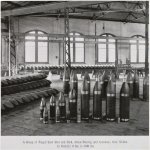You are using an out of date browser. It may not display this or other websites correctly.
You should upgrade or use an alternative browser.
You should upgrade or use an alternative browser.
Picture of the day
- Thread starter jwhc
- Start date
Dark Alley Dan
CGN Ultra frequent flyer
- Location
- Darkest Edmonton
That is a steely-eyed mofo.
Dark Alley Dan
CGN Ultra frequent flyer
- Location
- Darkest Edmonton
So I'm watching Death in the Garden, a French film shot in Mexico in the 1950's. Not a fantastic movie, but pretty good. A douchcanoe of a guy and his motley band are being pursued by the Federales. This shot shows up:

No idea what the LMG is.

So I go searching and it turns out it's a Mendoza M.1934. Never even heard of it. Kind of a Mexican BAR.


Turns out Ian did an episode on this type a year ago:
Damn poor day when you don't learn something.

No idea what the LMG is.

So I go searching and it turns out it's a Mendoza M.1934. Never even heard of it. Kind of a Mexican BAR.


Turns out Ian did an episode on this type a year ago:
Damn poor day when you don't learn something.
Without a doubt, some conscientious tw4t turned it in as part of the Dutch, civilian disarmament program. Now as then, they have chosen mercantile prosperity over defense. 5 Days.
That's the look of men who just saw an artillery or airstrike "solve the problem."
fat tony
CGN Ultra frequent flyer
So I'm watching Death in the Garden, a French film shot in Mexico in the 1950's. Not a fantastic movie, but pretty good. A douchcanoe of a guy and his motley band are being pursued by the Federales. This shot shows up:

No idea what the LMG is.



Last edited:

"Shooting up an oil tank on fire to prevent explosion and wide spread fire. Oil men in big tank field fire cannon balls into big tank when it catches fire. The holes let oil run out into softer embankment enclosure and prevents explosion." 1914
If only I knew I could have written my cannon off for work purposes.
Attachments
fat tony
CGN Ultra frequent flyer
View attachment 765739
Midvale Steel Company 1905
Lucien Yeoman concrete lathe being fitted up, WWI era, approximately 1917.
'Shell crisis'
Thanks for posting this pic. It shows that even at this late date both soldiers have the early issue leather equipment as evidenced by their shoulder strap attachments. So webbing was not universal issue throughout the war. Lewis guns are heavy beasts. The box appears to have a
six magazine capacity too and when fully loaded also was a heavy carry. Must have been strong gents as with say 50 lbs of other standard equipments men were pack horses with a hard walk through mud to the forward positions. Difficult for me to imagine. John
six magazine capacity too and when fully loaded also was a heavy carry. Must have been strong gents as with say 50 lbs of other standard equipments men were pack horses with a hard walk through mud to the forward positions. Difficult for me to imagine. John
In the fall of 1917, the United States had declared war on Germany and found its factories better suited for Model T’s than howitzers. The country needed to rev its production engines to make ordnance as quickly as possible. Gun boring and shell shaping, however, required precise, hand- made iron lathes fashioned by journeymen metal workers. Creating the machines needed to create the war machines would take months. Then, an inventor named Lucien Yeomans patented a method for building lathes designed for specific tasks using concrete, pre-fabricated metal and jigs to precisely place the parts. The process eliminated the need for highly skilled handwork, reduced production time by months and costs by so much that the new machines were considered disposable. According to Shannon DeWolfe, Yeoman’s biographer, that lathe was instrumental in the Allies’ success in the war. But the design has fallen into the cracks of history and is no longer in use.
Now, Pat Delany, inventor of the Multimachine, is leading a small group of engineers to revive Yeomans’ technology and put it to more peaceful use in developing countries. This time, though, there are no patents. The design is public, using online collaboration tools and open-source software. Delany’s team is nearing completion of a construction manual for a Yeomans-inspired screw-cutting lathe built with concrete and scrap metal. The goals are two-fold: affordability and precision. And the hope is that these lathes will soon churn out parts for tools and machines, including complex parts such as those that compose engines, pumps, and even other lathes.
This is one of Tyler Disney’s renderings of the concrete lathe made with free and open-source programs. Image credit: Tyler Disney
Makers needed
Delany is calling on the E4C community for a volunteer to build a 300lb version. The cost of concrete and steel is on him, he says. He plans to show the lathe at Maker Faire Africa in Cairo in October and, afterward, at engineering events in the United States.
“Whoever builds the machine can have it afterward. It would be a great way to learn a vital but forgotten technology,” Delany says. Those interested can contact him through his Open Source Machine Tools group on Yahoo.
Public review
Before unveiling the construction guide, Delany’s team is opening the design to public review. That work should begin soon at the lathe’s online home in a Yahoo group, where Delany has collaborated on his machine designs for the past few years. The lathe has a second home on E4C, too, and supporting documents and new renderings are available here [coming soon].
Now, Pat Delany, inventor of the Multimachine, is leading a small group of engineers to revive Yeomans’ technology and put it to more peaceful use in developing countries. This time, though, there are no patents. The design is public, using online collaboration tools and open-source software. Delany’s team is nearing completion of a construction manual for a Yeomans-inspired screw-cutting lathe built with concrete and scrap metal. The goals are two-fold: affordability and precision. And the hope is that these lathes will soon churn out parts for tools and machines, including complex parts such as those that compose engines, pumps, and even other lathes.
This is one of Tyler Disney’s renderings of the concrete lathe made with free and open-source programs. Image credit: Tyler Disney
Makers needed
Delany is calling on the E4C community for a volunteer to build a 300lb version. The cost of concrete and steel is on him, he says. He plans to show the lathe at Maker Faire Africa in Cairo in October and, afterward, at engineering events in the United States.
“Whoever builds the machine can have it afterward. It would be a great way to learn a vital but forgotten technology,” Delany says. Those interested can contact him through his Open Source Machine Tools group on Yahoo.
Public review
Before unveiling the construction guide, Delany’s team is opening the design to public review. That work should begin soon at the lathe’s online home in a Yahoo group, where Delany has collaborated on his machine designs for the past few years. The lathe has a second home on E4C, too, and supporting documents and new renderings are available here [coming soon].
Looks less at work than plinking? Wierd pose, no one else looking serious, and someones sporter rifle?
Looks like a German sporting rifle with the high mounted scope that someone picked up in that town?
In the fall of 1917, the United States had declared war on Germany and found its factories better suited for Model T’s than howitzers. The country needed to rev its production engines to make ordnance as quickly as possible. Gun boring and shell shaping, however, required precise, hand- made iron lathes fashioned by journeymen metal workers. Creating the machines needed to create the war machines would take months. Then, an inventor named Lucien Yeomans patented a method for building lathes designed for specific tasks using concrete, pre-fabricated metal and jigs to precisely place the parts. The process eliminated the need for highly skilled handwork, reduced production time by months and costs by so much that the new machines were considered disposable. According to Shannon DeWolfe, Yeoman’s biographer, that lathe was instrumental in the Allies’ success in the war. But the design has fallen into the cracks of history and is no longer in use.
Now, Pat Delany, inventor of the Multimachine, is leading a small group of engineers to revive Yeomans’ technology and put it to more peaceful use in developing countries. This time, though, there are no patents. The design is public, using online collaboration tools and open-source software. Delany’s team is nearing completion of a construction manual for a Yeomans-inspired screw-cutting lathe built with concrete and scrap metal. The goals are two-fold: affordability and precision. And the hope is that these lathes will soon churn out parts for tools and machines, including complex parts such as those that compose engines, pumps, and even other lathes.
This is one of Tyler Disney’s renderings of the concrete lathe made with free and open-source programs. Image credit: Tyler Disney
Makers needed
Delany is calling on the E4C community for a volunteer to build a 300lb version. The cost of concrete and steel is on him, he says. He plans to show the lathe at Maker Faire Africa in Cairo in October and, afterward, at engineering events in the United States.
“Whoever builds the machine can have it afterward. It would be a great way to learn a vital but forgotten technology,” Delany says. Those interested can contact him through his Open Source Machine Tools group on Yahoo.
Public review
Before unveiling the construction guide, Delany’s team is opening the design to public review. That work should begin soon at the lathe’s online home in a Yahoo group, where Delany has collaborated on his machine designs for the past few years. The lathe has a second home on E4C, too, and supporting documents and new renderings are available here [coming soon].
ht tps://www.youtube.com/watch?v=sFrVdoOhu1Q&pp=ygUNZ3Jhbml0ZSBsYXRoZQ%3D%3D
Dark Alley Dan
CGN Ultra frequent flyer
- Location
- Darkest Edmonton
That's either a great big guy or a teensy helmet...

















































































